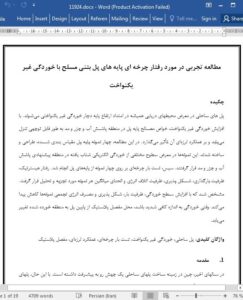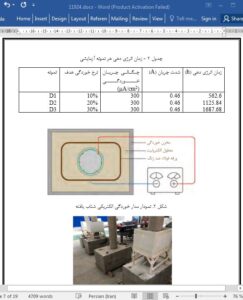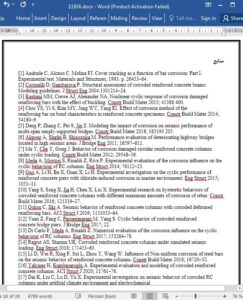Abstract
Coastal bridges exposed to the marine environment always suffer from non-uniform corrosion along the pier height. As the non-uniform corrosion increase, the material properties of the pier in the splash and tidal zone deteriorates significantly, affecting the seismic performance of the pier. In this study, four scaled bridge pier specimens were designed and fabricated. These specimens were subjected to different level of electrical accelerated corrosion in the proposed splash and tidal zone. Then, the cyclic load tests were conducted on the four bridge pier specimens. The hysteretic behavior, loading capacity, ductility, energy dissipation capacity and mean curvature of each specimen were analyzed. It was found that with increasing corrosion level, the load capacity, ductility and cumulative energy consumption of the specimens decreased. When the corrosion was severe enough, the location of the plastic hinge will transfer from the pier bottom to the corroded zone.
1. Introduction
In recent years, China has made a developmental leap in coastal bridge construction. However, the coastal bridges are usually exposed to harsh environments for significant periods of time. The problem of steel reinforcement corrosion caused by chloride penetration has become more prominent. The continuous chloride penetration will reduce reinforcement area[1], material strength [2,3], and bond between reinforcement and concrete[4] . Moreover, Due to most areas of China are at risk of earthquakes, coastal bridges may face a dual threat of harsh environmental conditions and earthquakes. Piers are the primary loadbearing members for bridge structures, and the severe deterioration of piers will reduce the seismic performance of coastal bridges [5]. To ensure the safety of coastal bridges, it is necessary to investigate the seismic performance of corroded piers and provide appropriate suggestions for the design and retrofit of coastal bridges [6] .
4. Conclusions
This study considers the non-uniform corrosion of coastal bridge piers. Four pier specimens with different corrosion levels in the proposed corrosion zone were designed and cyclic load test was performed. Based on the test results, the main conclusions are as follows:
(1) Three bridge pier specimens were corroded using the electrical accelerated corrosion test. Comparing the actual average mass loss percentage of the reinforcements of each specimen with the target corrosion rate, the electric accelerated corrosion test can obtain relatively ideal test corrosion rate.
(2) Comparing with the uncorroded specimen, the corroded specimens showed a poor hysteresis performance, of which the peak load decreased by up to 23.3% while the ductility down to 45% and the accumulated energy consumption decreased from 16.9kN⋅m to 1.8kN⋅m.











